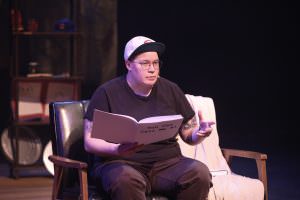REVIEW You Can Call Me Al

Continuing Recital’s sponsored partnership with the New Hazlett Theater, we are presenting a series of editorially-independent previews and reviews of the 2018–2019 Community Supported Art (CSA) Performance Series. Below is our review of Porto Domi by Felicia Cooper, a collaborative response from Recital editor David Bernabo, season review panelists Maree ReMalia and Jason Baldinger. Read their bios at the end of the review.
By David Bernabo
Review: ‘You Can Call Me Al’ Is A Story Worth Telling
Ali Hoefnagel presents a vulnerable yet humorous story of their life
With You Can Call Me Al, Ali Hoefnagel presents a vulnerable retelling of their life, centering on the realization of their transgender identity and all the varied ways that that personal detail bounces against a world that is less than accepting. That may sound quite heavy — and it is, along with poignant and tear-inducing and human — but the piece is also filled with humorous quips and ad libs, and is so cleverly told, bouncing back and forth through time, that its 75-minute runtime flies by.
You Can Call Me Al questions whose stories can be told. It is certainly ok to tell your own story, but when your story overlaps with the stories of others, where do you stop? As the piece takes great care to navigate these waters, it seems insensitive to casually gloss over plot points in summary for a critique. So at this point, the review panel wants to mention that certain aspects of the performance are delicate and personal, and we feel that, if you haven’t already, you should try to seek out an upcoming performance to get the full impact of the work. To that end, we won’t be revealing many spoilers in this review.
You Can Call Me Al is a one-person show augmented with live musical interludes by violinist and vocalist Gray Buchanan. The music seems to draw on traditional Irish or Nordic folk music, employing a wonderful array of double stops. Buchanan wrote three musical motifs that are the basis for two sung songs and ambient music in support of the storytelling. The songs, which are performed on a second level at the back of the stage, allow the audience to acknowledge space away from the stage floor. As the songs represent an abstracted compliment to the literal storytelling, this particular use of space further abstracts the world in which the story is housed.
Photo by Renee Rosensteel
